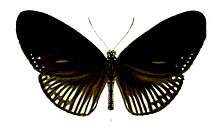Euploea alcathoe
Euploea alcathoe, commonly known as the no-brand crow, Eichhorn's crow or striped black crow, is a common butterfly found from India to Borneo, and in the Moluccas, New Guinea and Australia. It belongs to the crows and tigers subfamily of the Nymphalidae (brushfooted butterflies).
| No-brand crow | |
|---|---|
 | |
| Scientific classification | |
| Kingdom: | |
| Phylum: | |
| Class: | |
| Order: | |
| Family: | Nymphalidae |
| Genus: | |
| Species: | E. alcathoe |
| Binomial name | |
| Euploea alcathoe | |
| Synonyms | |
| |
The wingspan is about 80 millimetres (3.1 in). Adults are black, fading somewhat towards the wing margins. There are arcs of white spots at each forewing apex and around each hindwing termen.[2] The butterflies keep to within 3 metres (9.8 ft) of the ground and they can be found in patches of sun underneath the forest canopy where they alight on understory leaves and small twigs.[3]
The larvae feed on Nerium indicum, Nerium oleander, Mandevilla, Asclepias, Hoya australis, Marsdenia australis, Ficus platypoda, Gymnanthera oblonga and Ficus obliqua in Australia.[4] The larvae of the endangered Gove subspecies, Euploea alcathoe enastri, also feed on the vines of Parsonsia alboflavescens,[5] and Tylophora benthamii.[3] Young larvae are pale orange with four pairs of black tentacles (filaments). Later instars develop a black and white pair of bands and several black bars on each abdominal segment. Full-grown larvae reach a length of 50 millimetres (2.0 in).
Euploea alcathoe adults are most common in the monsoonal wet season between December and May in Australia, and there may be several generations over the course of a year.[3]
Subspecies
- Euploea alcathoe alcathoe
- Euploea alcathoe eichhorni Staudinger, 1884 (Cape York to Ingham)[3]
- Euploea alcathoe enastri (Gove Peninsula)[3]
- Euploea alcathoe alecto Butler, 1866 (Buru, Ambon, Serang)
- Euploea alcathoe zodica Fruhstorfer, 1904 (Obi)
- Euploea alcathoe pierretii C. & R. Felder, [1865] (West Irian)
- Euploea alcathoe macgregori Kirby, 1889 (D'Entrecasteaux Islands)
- Euploea alcathoe diadema Moore, 1883 (Papua, Goodenough)
- Euploea alcathoe coffea Fruhstorfer, 1910 (eastern New Guinea, Karkar Island)
- Euploea alcathoe samaraina Carpenter, 1953 (south-eastern Papua New Guinea: Samarai Island)
- Euploea alcathoe monilifera (Moore, 1883) (Cape York, Thursday Island)[3]
Conservation
The subspecies enastri of the Gove Peninsula is classified as endangered. Males have been collected from glades in rainforest and females from adjacent paperbark swampland. It is threatened by habitat destruction and degradation by water buffalo and feral pigs, and by invasion of its environment by the yellow crazy ant (Anoplolepis gracilipes).[5]
References
- Euploea at funet.fi
- Australian Insects
- Braby, Michael F. (2004). Complete Field Guide to Butterflies of Australia. Collingwood, Victoria: CSIRO Publishing. pp. 194–95. ISBN 0-643-09027-4.
- Kitching, Roger Laurence (1999). Biology of Australian butterflies. Collingwood, Victoria: CSIRO Publishing. p. 198. ISBN 0-643-05027-2.
- Braby, Michael; Wilson, Colin (December 2006). "Threatened Species of the Northern Territory: Gove Crow Euploea alcathoe enastri" (PDF). Archived from the original (PDF) on 28 March 2011. Retrieved 12 December 2011.
| Wikimedia Commons has media related to Euploea alcathoe. |